
Directions
-
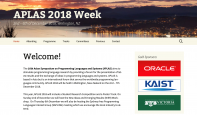
APLAS 2018 국제학회 개최 (KAIST 후원, 류석영 교수 Program Chair..
KAIST가 Gold Sponsor로 지원한 국제학회인 16번째 APLAS (Asian Symposium on Programming Languages and Systems)가 2018년 12월 3일-5일 뉴질랜드 웰링턴에서 개최되었다. KAIST 전산학부의 류석영 교수가 프로그램 체어로 세계적 연구자인 Amal Ahmed (Northeastern University, USA), Azalea Raad (MPI-SWS, Germany), Bernhard Scholz (University of Sydney, Australia) 세 강연자를 초청하고, 2박 3일간 논문 발표와 포스터 세션, 12월 2일, 12월 6일의 웍샵까지 다양한 프로그램을 진행하였다.
...Read more -
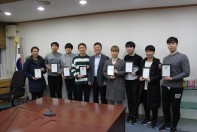
NAVER Phd Fellowship 선정
지난 11월 우리 전산학부 박사과정 10명이 NAVER Phd Fellowship에 선정되었다. 선정자는 - 공태식(지도교수: 이성주) - 권 현(지도교수, 윤현수) - 김형규(지도교수: 김순태) - 남재현(지도교수: 신승원) - 박준영(지도교수: 류석영) - 박진석(지도교수: 이흥규) - 장영수(지도교수: 김기응) - 전석준(지도교수: 김민혁) - 정대룡(지도교수: 신인식) - 하재희(지도교수: 김명철) 총 10명으로 NAVER PhD Fellowship프로그램은 전산 각 분야의 top-tier 컨퍼런스/저널에 제1저자논문을 제출한 박사과정 학생을 선발하여 장학금을 지급하는 프로그램이다. 네이버사는 NAVER Phd Fellowship 2015년 8명, 2016년 1차 6명, 2차 8명, 2017년 11명, 2018년 10명을 선정했으며 총 2억 3천 5백만원을 선정된 학생들에게 지급하였다.
...Read more -
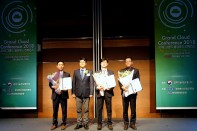
‘K-ICT 클라우드 산업대상’ 수상
27일 서울 코엑스에서 열린 ‘2018 그랜드 클라우드 컨퍼런스’에서 우리 전산학부에서 사용중인 클라우드 구축 및 운영 사례로 ‘2018 K-ICT클라우드 산업대상’(장관상)을 수상했다. 본 수상은 클라우드 운영시스템을 유휴 장비에 구축하여 동시 기준 300 VM이상을 지속적으로 정규 교과목 및 연구과제를 위해 컴퓨팅을 제공한 사례와 오픈소스인 오픈스택을 활용한 운영시스템으로 적용한 사례를 우수 사례로 인정받았다. 한편, ‘2018 그랜드 클라우드 컨퍼런스’는 국내 클라우드 산업의 성과를 정리하고 향후 발전 방향을 공유하는 클라우드 전문 컨퍼런스로 공공 및 민간부문 클라우드 도입과 융합에 대해 논의하는 자리이다.
...Read more -
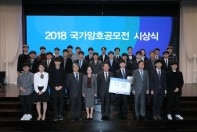
2018 국가암호공모전 대상 수상
KAIST 전산학부 정보보호대학원 박사과정 최원석 학생과 석사과정 이병학 학생(지도교수 이주영)이 2018 국가암호공모전에서 “Indifferentiability of Truncated Random Permutations” 논문으로 대상을 수상하였다. ‘2018 국가암호공모전’은 국내 암호기술 발전을 위해 국가정보원의 후원으로 한국암호포럼과 한국정보보호학회, 국가보안기술연구소에 의해 개최되었으며 총 상금은 대상 1,000만원을 포함해 총 5,000만원 규모이다. 암호공모전은 △암호 논문분야 △암호 문제풀이 분야 △암호 활용 아이디어 분야로 나뉘어 진행되고 이 중 대상은 전체 분야를 통틀어 오직 암호 논문분야에서 한 편만 선정된다. 시상식은 미래암호워크숍의 부대 행사로 11월 15일 서울 라마다서울 호텔에서 진행됐다. 또한 암호 논문분야에서 박사과정 김성광 학생(지도교수 이주영)이 장려상을 수상하고, 박사과정 김성광, 최원석, 석사과정 이영민 학생(지도교수 이주영)이 특별상을 수상하였으며, 정보보호대학원 차상길 교수가 지도하는 KAIST 해킹 동아리 GoN의 학부생들로 이루어진 두 팀이 문제풀이 분야에서 각각 최우수상과 장려상을 수상하였다. 한편, 국가암호기술 전문인력 양성과정 시상식에서 KAIST 전산학부 박사과정 이지은 학생이 최우상에, 본 대학원 석사과정 이병학 학생이 우수상에 입상하였다. 이병학 학생은 2017 암호공모전에서도 “Tweakable Block Ciphers Secure Beyond the Birthday Bound in the Ideal Cipher Model“ 논문으로 최우수상을 수상한 바 있으며, 이 논문은 올해 3대 암호학회 Asiacrypt에 채택되었다.
...Read more -
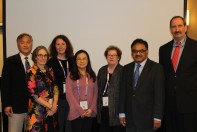
박진아 교수 International Conference on Medical Imaging..
KAIST 전산학부 박진아교수는 지난 10월 26~28일 미국 볼티모어에서 개최 된 International Conference on Medical Imaging and Case Reports 2018에서 “Hippocampal Morphology Study based on Progressive Template Deformable Model” 주제로 기조강연을 하였다. 이번 행사에는 23개국의 48기관에서 70여명이 참석하였고, 기조강연자로 Harvard Medical School의 Martha Shenton 박사, MIT의 Polina Golland 교수, Johns Hopkins University의 Michael Miller, Jeffery Siewerdsen 교수 등 특히 의료영상과 임상분야에서 영향력이 있는 연구를 하고 있는 연구자들이 다수 초청된 행사였다.
...Read more -

KAIST 전산학부 유신 교수, 소프트웨어 공학 분야에서 가장 영향력있는 신진 연구자 15..
전산학부 유 신 교수가 소프트웨어 공학 분야에서 가장 영향력 있는 신진 연구자 15명 중 한 명으로 선정되었다. 이 결과는 Journal of Systems and Software 학술지에 2018년 10월에 발표된 SE분야 문헌 연구(Karanatsiou et al., https://doi.org/10.1016/j.jss.2018.10.029)에 따른 것으로, 2010년부터 2017년 사이 우수 저널 및 학회에 발표된 14,456편의 논문 및 피인용지수를 바탕으로 집계되었다.
...Read more -
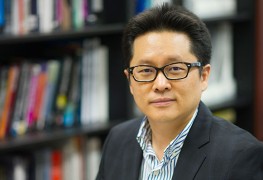
김민혁 교수, 2018 국가연구개발 우수성과 100선 선정
김민혁 교수, 2018 국가연구개발 우수성과 100선 선정 과학기술정보통신부와 한국과학기술기획평가원이 발표한 '2018년 국가연구개발 우수성과 100선'에 우리 대학 교수 6명이 선정됐다. 수상자는 신소재공학과 김일두, 박병국 교수, 의과학대학원 김호민 교수, 생명화학공학과 이재우 교수, 전산학부 김민혁 교수, 전기및전자공학부 최경철 교수이다. 전산학부 김민혁 교수는 정보·전자 분야 우수성과에 선정됐다. 극사실적 영상 획득을 위한 고성능 영상처리 기술을 개발한 성과를 인정받았다. 김일두 교수는 기계·소재 분야 최우수 성과에 선정됐다. 자기조립 유기체 복합촉매 커플링 기반의 초고감도 가스센서 플랫폼소재를 개발한 공을 인정받았다. 박병국 교수도 기계·소재 분야 우수성과에 선정됐다. 열로 스핀전류를 얻는 소재기술을 개발했다. 의과학대학원 김호민 교수는 생명·해양 분야 최우수성과에 선정됐다. 시냅스형성을 조절하는 핵심단백질의 3차 구조와 분자기전을 규명했다. 이재우 교수는 에너지·환경 분야 우수성과에 선정됐다. 이산화탄소를 원료로 한 고부가가치 탄소 물질 합성 기술을 개발한 공을 인정받았다. 최경철 교수는 정보·전자 분야 우수성과에 선정됐다. 옷 위에 구현된 부드러운 디스플레이를 개발한 성과를 인정받았다. 우수성과로 선정된 성과는 과학기술정보통신부장관의 인증서와 현판이 수여된다. 선정된 6명의 교수에게는 국가연구개발 성과평가 유공포상(훈·포장, 대통령표창, 국무총리표창 등) 후보자로 추천되고, 신규 연구개발(R&D) 과제 선정에서 우대받게 된다.
...Read more -

KAIST 전산학부 양은호, 황성주 교수 연구실 공동으로 NIPS 2018에 우수 논문 3..
KAIST 전산학부 양은호, 황성주 교수 연구실 공동연구로 “DropMax: Adaptive Variational Softmax”, "Uncertainty-Aware Attention for Reliable Interpretation and Prediction", “Joint Active Feature Acquisition and Classification with Variable-size Set Encoding” 세 편의 논문을 세계적으로 최우수 학회인 Neural Information Processing System (NIPS) 2018 (acceptance rate:20.8 %) 발표했다. 발표된 논문은 다음과 같다. [DropMax: Adaptive Variational Softmax] 본 논문에서는 기존의 다중클래스 분별에 적용되는 Softmax 함수에 Dropout 테크닉을 적용하여 분별기의 성능을 향상시키는 기법을 제안하였다. 각 학습 분기 마다 전체 클래스의 부분집합이 학습된 Dropout 확률에 따라 임의로 샘플되어 분별이 수행된다. 이는 서로 다른 분별기의 앙상블이라는 의미가 있으며, 또한 서로 헷갈리기 쉬운 클래스들끼리 더 많이 비교하게 하는 효과를 가져온다. 딥 베이지안 기법을 통해 이러한 확률적인 뉴럴 네트워크의 학습과 추론이 가능하다. 특히 본 논문에서는 각 클래스 당 타겟 레이블일 확률, 즉 Dropout 마스크를 각 입력 인스턴스 별로 다르게 생성하도록 유도하고 그 값들을 정확히 추론하는 것이 성능 향상에 중요함과, 그로 인해 더 안정적인 학습과 추론이 가능함이 실험적으로 확인되었다. [Uncertainty-Aware Attention for Reliable Interpretation and Prediction] 기존의 심층 신경망은 예측 모델의 심층 학습 과정에서 불확정성을 고려할 수 없어 학습 모델이 잘못된 상황을 예측할 가능성이 존재하고, 데이터와 모델 자체에서 존재하는 불확정성으로 인해 잘못된 예측 결과가 도출되는 문제점이 있었다. “Uncertainty-Aware Attention for Reliable Interpretation and Prediction” 논문은 기존의 불확정성(Uncertainty) 문제를 극복하기 위한 방법으로 데이터와 모델 condition을 파악하여 input-adaptive한 유기적 학습이 가능한, 불확정성을 고려하는 주의 집중 메카니즘(Uncertainty-Aware Attention Mechanism, UA)을 제시하였다. 본 논문은 UA 프레임워크를 통해, 최신 기계 학습 알고리즘 성능 대비, 모델 예측 성능과 불확정성이 보정된 정확한 모델 해석 능력 능력이 비약적으로 뛰어남을 실험적으로 입증하였다. [Joint Active Feature Acquisition and Classification with Variable-size Set Encoding 본 논문에서는 병의 진단과 같이 분류 (Classification)를 함에 있어 필요한 정보를 얻는 데 비용 (예: 검사비용) 이 드는 상황에서 적은 비용으로 효과적인 정보를 얻기 위한 정책을 학습하는 문제를 다룬다. 환자들을 진단할 때 모두 같은 종류의 검사를 진행하여 진단하기 보다는 각 개인의 상태에 따라 필요한 검사를 하는 것이 합리적이라고 할 수 있다. 본 논문에서는 현재 가진 정보를 기반으로 필요한 정보를 순차적으로 결정하는 동적 피쳐 획득 정책과 분류모델을 공동 학습한다. 이를 위해, 분류성능과 정보를 얻는데 필요한 비용을 모두 고려하는 목적함수를 정의하고, 심층 강화학습을 이용한 피쳐 획득 정책과 분류 모델의 공동 학습 프레임워크를 제시하였다. 또한 합성 데이터와 의료 데이터를 이용한 실험을 통해 정적인 피쳐 획득방법이나 기존의 선행 연구에 비해 비용 효율적인 성능을 보임을 확인하였다
...Read more -

KAIST 전산학부 지능형서비스통합(ISI) 연구실과 글로벌 H사, 글로벌 실내위치인식 시..
전산학부 지능형서비스연구실(지도교수 한동수)이 글로벌사인 H사와 글로벌 실내위치인식 시스템 (Global Indoor Positioning System) 개발을 위한 국제 산학 프로젝트를 수행하기로 하였다. 기술이전과 함께 진행되는 이번 프로젝트를 위해 글로벌 H사는 카이스트에 40만불을 지원할 예정이다. 2014년 KAIST Indoor Positioning System (KAILOS)를 개발하여 일반에 공개하고 있는 ISI 연구실은 최근 불특정 다수의 스마트폰 사용자로부터 얻어진 무선신호의 수집위치를 자동으로 라벨링하는 크라우드소싱 AI 기법을 개발한 바 있다. 이번 국제 공동 프로젝트에서는 카이스트가 보유하고 있는 크라우드소싱을 활용한 위치 라벨링 AI 기법을 상용화 수준으로 고도화할 예정이다. 프로젝트가 성공적으로 수행되면 H사는 카이스트가 개발한 시스템을 자사의 제품에 탑재하여 상용화할 것으로 기대된다. 향후 1년 동안 진행될 H사와의 국제 산학 프로젝트를 지휘할 한동수 교수는 “카이스트가 개발한 기술이 국내 기업에 앞서 해외 기업을 통해서 상용화 시도가 이루어지게 되어서 아쉽다. 위치 서비스에 대한 국내의 규제가 지나치게 엄격하여 초래된 결과다.”라고 하였다. 또 한동수 교수는 “카이스트가 개발한 기술에 대해서 글로벌 기업이 인정하고 상용화를 위한 산학 프로젝트를 의뢰한 것은 큰 의미가 있다. 기술은 지속적으로 발전하지 않으면 쇠퇴하고 소멸한다. 향후에도 실내 위치인식 분야에서 지속적으로 국제 산학협력을 확대해 나갈 것이다.” 라고 하였다.
...Read more -

김광조 교수 인공지능을 이용한 네트워크 침입 탐지에 관한 영문 저서 출간
KAIST(총장: 신상철) 전산학부 정보보호대학원 김 광조교수는 인도네시아 박사과정 유학생인 Muhamad Erza Aminanto와 Harry Chandra Tanuwidjaja와 함께 정보통신기술진흥센터(IITP)에서 2013년 4월부터 2018년 2월 까지 카이스트에 지원한 “생체 모방 알고리즘(Bio-Inspired Algorithm)을 활용한 통신 기술 연구“ (연구책임자:박홍식 교수) 과제의 성과물로 “Network Intrusion Detection using Deep Learning: A Feature Learning Approach”(심층 학습을 이용한 네트워크 침입 탐지-특장점 학습 측면에서)라는 영문 서적을 저술하였으며 2018년 9월 독일의 저명 출판사인 Springer에서 사이버 보안 시스템과 네트워크 시리즈 중 한 분야로 발행하였다(첨부 사진) 이 도서는 컴퓨터 비전, 자연어 처리, 이미지 처리 등의 분야에서 많은 활용이 되고있는 인공지능 기법인 심층 학습을 사용한 각종 침입 탐지 시스템에 관한 구성 방식을 소개하고 침입 트래픽의 특장점 추출 및 학습하여 기존 방식에 비교하여 매우 높은 정탐율(99.918%)과 낮은 오탐율(0.012%)을 갖는 침입탐지 기법을 상세히 기술하였고, 부록에는 악성 코드 탐지를 위한 인공 지능 기법에 관한 기술 동향을 첨부하였다. 본 도서는 사이버 보안과 인공 지능의 접목에 관하여 학부 및 대학원생, 연구·개발 담당자에게 실질적인 사이버 보안 시스템 구축에 관한 전문 지식을 제공하는 좋은 지침서가 될 것이다. 참조: https://www.springer.com/gp/book/9789811314438
...Read more -

KAIST 전산학부 김문주 교수 제15회 FACS 국제 학회 키노트 발표
KAIST 전산학부 김문주 교수가, 2018년 10월 10-12일에 열리는 제15회 Intl. Conf. on Formal Aspects of Component Software (FACS) 에 UC Berkeley의 Edward Lee 교수, UIUC의 Gigore Rosu 교수와 함께 키노트 연사로 초빙 되었다. http://sevlab.postech.ac.kr/facs18/invited-speakers/ 키노트 제목: Lessons Learned from Automated Analysis of Industrial SW for 15 Years
...Read more -

황성주 교수 구글 AI 집중 연구 어워즈 프로그램 수상
지난 9월 13일 Google 한국 블로그를 통해 발표된 구글 AI 집중 연구 어워즈 프로그램에 우리 전산학부 황성주 교수가 수상자로 선정되었다. 관련기사: https://korea.googleblog.com/2018/09/googleaifocusedresearchawardsprogram.html
...Read more -

좌훈승 박사 DGIST 정보통신융합전공 조교수로 임용
우리 전산학부 출신의 좌훈승 박사 (지도교수: 신인식)가 2018년 8월6일부로 DGIST 정보통신융합전공 조교수로 임용되었다. 좌훈승 교수는 2009년, 2011년, 2016년에 KAIST 전산학부에서 학사, 석사, 박사 학위를 받고, 이후 2016년 10월부터 1년 10개월간 University of Michigan에서 research fellow로 근무하였다. 주 연구 분야는 사이버 물리 시스템 및 실시간 시스템으로 실시간성 보장 및 효율적인 자원 관리에 관한 다양한 연구를 중점적으로 진행하고 있다. 지금까지 실시간 시스템 분야의 최우수 학술대회/학술지인 IEEE RTSS, IEEE RTAS, ACM EMSOFT, IEEE TPDS 등에 15여편 이상의 논문을 발표하였다. 또한, 2012년 IEEE RTSS와 2014년 IEEE CPSNA에서 각각 최우수 논문상 (Best Paper Award)을 수상하였다.
...Read more -
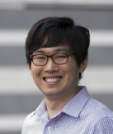
이영기 박사 서울대학교 컴퓨터공학부 조교수 임용
우리 전산학부 출신의 이영기 박사(지도교수: 송준화)가 2018년 9월부로 서울대학교 컴퓨터공학부 조교수로 임용되었다. 이영기 박사는 우리 학부에서 학사 석사 박사 과정을 졸업했다. 이후 2013년부터 싱가포르 경영대학 교수로 일하였고 이번 9월에 서울대학교 컴퓨터공학부에 부임하게 되었다. 이영기 교수는 Mobile and ubiquitous systems, OS support for mobile/IoT/wearable devices, large-scale data analytics and experimentation platform, computational social sciences 등의 분야에서 활발하게 연구하고 있으며, 관련 분야의 최고 학회인 ACM MobiSys, ACM SenSys, ACM/IEEE IPSN, ACM UbiComp, ACM CSCW, ACM CHI 등에 많은 논문을 발표했다. 또한 학회 프로그램위원회와 조직위원회에서 활발하게 활동하고 있으며, 2018년 ACM UbiComp program co-chair 역할을 수행하고 있다.
...Read more -

황성주 교수 구글 AI 집중 연구 어워즈 프로그램 수상
지난 9월 13일 Google 한국 블로그를 통해 발표된 구글 AI 집중 연구 어워즈 프로그램에 우리 전산학부 황성주 교수가 수상자로 선정되었다. 황성주 교수는 Kristen Grauman 교수 지도 하에 텍사스 어스틴 대학교에서 컴퓨터 과학 박사학위를 취득하였으며, 학위과정 동안 서던 캘리포니아 대학교의 Fei Sha 교수와 긴밀하게 협업하였다. 학위 취득 후 디즈니 리서치에서 Leonid Sigal 교수와 함께 박사후 연구원으로 일하였으며, 울산과학기술원 전기컴퓨터 공학부 조교수를 거쳐 현재 한국과학기술원 전산학부 조교수로 근무하고 있다.
...Read more -
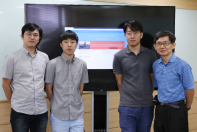
KAIST, 인공신경망 기반 워터마킹 기술 개발
전산학부 이흥규 교수의 "KAIST, 인공신경망 기반 워터마킹 기술 개발" 관련 기사입니다. http://www.irobotnews.com/news/articleView.html?idxno=14980 http://news.mt.co.kr/mtview.php?no=2018091114354893731
...Read more -

전산학부 최기선 교수 COLING 2022 유치 확정
국제전산언어학술대회(International Conference on Computational Linguistics, 이하 COLING)의 2022 유치위원장인 전산학부 최기선 교수는 지난 8월 20일부터 26일까지 미국 뉴멕시코주 산타페시에서 개최된 ICCL 운영위원회 유치발표장에 참여하여 2022년 대한민국 경주에서의 제 29회 COLING 개최를 확정지었다. 전산언어학은 사람의 말과 글을 기계가 이해하고 반응하도록 하는 전산학과 언어학의 통합분야로 인공지능을 완성하는 제4차 산업혁명의 핵심 분야이다. COLING은 운영위원회 ICCL을 중심으로 전산언어학 분야에서 권위있는 ACL(The Association for Computational Linguistics)와 LREC(International Conference on Language Resources and Evaluation)과 연계해 2년마다 50개국 1200명 이상이 참가하는 세계적인 전산언어관련 컨퍼런스이다. Main Conference에는 약 1000여 편의 페이퍼가 제출되어 이들 중 약 300편 정도 발표되며, Main Conference외에 데모 세션, 튜토리얼 및 10여개의 워크샵으로 이루어져 있다. COLING 2022는 오는 2022년 10월 9일 한글날을 시작으로 약 일주일간 열릴 예정으로 되어 있으며, 향후 전산언어 관련 산업 발전과 인재양성에 크게 기여할 것으로 보고 있으며, 대한민국 전산언어학의 위상과 리더십을 선보일 수 있을 것으로 기대된다.
...Read more -

김민혁 교수, KAIST 6개의 핵심 특허기술에 선정 및 발표
김민혁교수, KAIST 6개의 핵심 특허기술 선정 및 발표 전산학부 김민혁교수님의 "초분광 영상기술"이 KAIST 6개의 핵심 특허기술에 선정되어, 2018년 9월10일 삼성동 코엑스 설명회에서 발표합니다. 본 행사는 면역 활성화 항암치료·AI 기반 초고화질 영상변환 기술 등 바이오·인공지능·나노기술·반도체 분야 등 6개 핵심 특허기술, 기업에 기술이전을 위한 설명회입니다. 2018 KAIST Core Tech Transfer Day website: http://tech4.kaist.ac.kr/ [관련기사: 전자신문] http://www.etnews.com/20180920000185 2018 KAIST Core Tech Transfer Day 소개 KAIST(총장 신성철)가 환자의 면역반응을 활성화시켜 인체 본연의 면역 시스템이 암세포를 사멸시키도록 유도하는‘면역 활성화 항암치료제’와 실시간 AI(딥러닝) 기술을 활용해 저해상도 영상을 고해상도 영상(4K UHD)으로 즉시 변환시키는‘초고화질 영상변환 하드웨어기술’등 당장 사업화 가능성이 높은 6개의 핵심 특허기술을 소개한다. KAIST는 10일 오후 1시부터 서울 삼성동 코엑스에서 산학협력단(단장 최경철) 주관으로‘2018 KAIST 핵심 특허기술 이전 설명회’를 개최한다고 3일 밝혔다. 이 설명회는 KAIST 연구진이 보유한 우수 기술을 기업에게 이전을 통해 일자리 창출은 물론 기업 경쟁력을 높이는 산학협력 모델을 조성키 위해 마련됐다. 산학협력단 관계자는“지난 3월 KAIST가 오는 2031년까지 세계 10위권 선도대학으로의 진입을 선포한 ‘KAIST 비전 2031’의 5대 혁신분야 중 하나인 기술사업화 혁신방안의 일환으로 이번 설명회를 준비했다”며 “핵심 특허기술을 선정해 기업에게 이전하는 설명회를 매년 개최할 방침”이라고 밝혔다. KAIST는 선정된 기술을 이전받는 기업들에게는 기술보증기금과 협력을 통해 기업금융연계 지원서비스를 제공할 계획이다. 이들 기업은 또 KAIST로부터 비즈니스 모델 개발과 특허-R&D 연계 전략분석, 국내·외 마케팅 우선 추진 등 다양한 서비스를 지원을 받게 된다. 올해 KAIST가 선보이는 기술은 4차 산업혁명의 중심이 되는 바이오, 나노, 인공지능, 반도체 분야의 핵심 특허기술로 ①새로운 방식의 나노 패터닝 플랫폼 기술(정희태 교수·생명화학공학과) ②면역 활성화 항암치료제후보 물질 확보(최병석 교수·화학과) ③미생물을 이용해 바이오연료 등을 대량생산할 수 있는 기술(이상엽 특훈교수·생명화학공학과) 등 이다. 이밖에 ④컴팩트한 싱글샷 초분광 카메라 기술(김민혁 교수·전산학부) ⑤AI(딥러닝) 기반 고속 초고해상도 업스케일링 기술(김문철 교수·전기및전자공학부) ⑥방사선에 강인한 모스펫 소자(이희철 교수·전기및전자공학부)도 6개 핵심 특허기술에 포함됐다. 특히, 김문철 교수와 김민혁 교수의 특허기술은 지난 8월 31일부터 9월 5일까지 독일 베를린에서 열린‘국제 가전 박람회(IFA 2018)’에서도 전시, 소개돼 참가자들로부터 많은 주목을 받은 기술이다. KAIST가 올해 선정한 6개 핵심기술은 산업계에 파급효과가 큰 기술로 향후 다양한 분야로의 응용 가능성과 시장규모·기술혁신성 등을 고려해 선정됐다. KAIST는 이를 위해 지난 4월부터 교수들이 직접 연구·개발해 특허를 보유한 교내 우수 기술을 대상으로 공모를 진행하고 접수된 특허기술을 대상으로 변리사·벤처 투자자·사업화 전문가 등 15명 내외로 구성된 심사단의 자문과 평가를 거쳤다. 9월 10일 진행되는 설명회에는 기술개발 및 기술이전을 포함한 상호 협력방안을 논의하기 위해 기업 관계자 및 투자자 등 200여 명이 초청될 예정이다. 연구자인 이상엽 특훈 교수 등 교수 6인도 모두 참석해 각 특허기술별로 15분씩 발표와 함께 현장에서 기술이전에 관한 상담 등도 진행한다. 이와 함께 신성철 총장을 비롯해 강낙규 기술보증기금 이사장 직무대행, 이준표 한국소프트뱅크 대표이사, 차기철 KAIST 동문회장 등 내·외빈이 참석해 4차 산업혁명 시대를 맞아 대학이 보유 중인 첨단기술에 관한 기술사업화의 중요성을 강조할 계획이다. 최경철 KAIST 산학협력단장은“이번 기술이전 설명회를 계기로 KAIST가 보유한 핵심 특허기술을 기업에게 적극적으로 소개하고, 양질의 일자리 창출과 함께 글로벌화 등 기업발전의 기회가 될 수 있는 산학협력의 성공적인 모델로 발전시켜 나갈 것”이라고 말했다. 최 단장은 이어“아직 발굴되지 않은 핵심 특허기술과 각종 사업추진 관련 아이디어 등을 지속적으로 발굴해 대학의 핵심기술을 활용한 기술사업화를 활성화하고 산학협력 사업을 적극적으로 추진해나갈 계획”이라고 밝혔다.
...Read more -
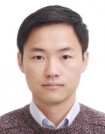
홍석인 박사 경북대 조교수 임용
카이스트 전산학부 졸업생인 홍석인 박사 (지도교수: 김순태)가 경북대학교 IT대학 컴퓨터학부 조교수로 임용되었다. 홍석인 박사는 졸업 후 삼성전자에서 책임연구원으로 근무하며 DRAM 설계에 관한 연구를 하였고, 이후 IBM TJ Watson Research Center에서 박사후 연구원으로 근무하면서 저전력 메모리 시스템, Near-Data Processing, Secure Processor Architecture 등에 대한 연구를 수행하였다. https://sites.google.com/view/seokinhong/
...Read more -
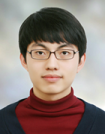
홍정규 박사 영남대학교 조교수 임용
카이스트 전산학부 졸업생인 홍정규 박사 (지도교수: 김순태)가 영남대학교 컴퓨터공학과 조교수로 임용되었다. 홍정규 박사는 박사학위 후 1년 간 임베디드 컴퓨팅 연구실에서 박사후 연구원으로 근무하며 신뢰성 및 저전력 메모리 시스템 연구를 수행하였다.
...Read more -

윤성의 교수 ACM Senior Member 선정
윤성의 교수가 2018년 6월에 ACM Senior Member로 선정 되었다. ACM(Association for Computing Machinery)은 1947년에 설립된 세계 최초의 컴퓨터 분야의 학술과 교육을 목적으로 하는 각 분야 학회들의 연합체로 2007년 현재 전 세계에 약 83,000명의 회원이 있으며, 10년 이상 기술적 리더쉽을 보인 ACM 회원을 senior member로 선정하고 있다. 이번 ACM senior member 로 선정된 윤성의 교수는 2015년 High Performance Graphics 학회에서 Test-of-Time 2006 수상과 Best paper award 수상, 2012~2013년 ACM Interactive 3D Graphics and Games (I3D) 공동 학회장 및 프로그램 Chair 활동, IEEE 및 ACM 학회에서 관련 연구분야로 다양한 tutorial을 개최 및 지금까지 약 70여편의 우수논문 발표와 높은 h-index 등의 성과를 인정받았다.
...Read more -

4차 산업혁명 시대의 전시 개선을 위한 스마트 과학관 전시 연구단 출범
[그림] 과학관 기술스택 관점에서 바라본 스마트 과학관 플랫폼 4차 산업혁명 시대의 전시 개선을 위한 스마트 과학관 전시 연구단 출범 (실내 위치인식 기술과 AR/VR, IoT, AI 기술을 융합시킨 전시 서비스 기술 개발) 과학관 전시 안내가 새로워질 전망이다. 카이스트(총장, 신성철)와 국립중앙과학관(관장, 배태민)은 실내위치와 AR/VR, IoT와 같은 4차 산업혁명의 핵심 기술들을 연계시켜 과학관 전시관을 안내하는 시스템을 개발하는 스마트 과학관 전시 연구단을 출범시켰다. 연구단은 전시기반기술, 전시운영기술 전시컨텐츠 분야에서 카이스트(전산학부 한동수, 박진아, 이기혁, 산업디자인학과 이우훈), 연세대, 한양대 등 9개의 대학과 전자부품연구원, 국립중앙과학관 등 6개의 연구기관이 총 15개 과제를 수행할 예정이다. 2018년 하반기부터 2022년도까지 4년 동안, 약 130억 원의 정부 예산이 투입될 예정이다. 그간 과학관 전시 안내는 자격증을 갖춘 전문적인 전시 안내자의 부족으로 많은 어려움을 겪어왔다. 스마트폰을 활용한 전시 안내의 효율화도 지지부진한 상태였다. 연구단이 목표로 하는 실내 위치기반 전시 안내 시스템이 출시되면 관람객들은 위치에 따라 AR/VR기법을 포함한 다양한 방식을 통해 전시물 안내 서비스를 받을 수 있다. 구체적으로 전시 안내자의 설명을 듣는 것과 유사한 서비스를 스마트폰을 통해서 제공 받게 된다. 관람자의 다양한 피드백이 과학관에 즉각적으로 전달되어 전시 개선에 활용하는 리빙랩 기법도 적용할 계획이다. 실내 위치는 카이스트에서 오랜 기간 개발해 온 실내 위치인식 시스템, KAIST Indoor Locating System (KAILOS)를 활용할 예정이다. 배정회 국립중앙과학관 전시단장은 "매년 수십만 명의 청소년이 과학관을 방문하고 있다. 이들에게 과학이 우리 사회의 발전에 이바지하는 다양한 사례를 전시를 통해 보여주고 과학을 통한 꿈과 영감을 심어 주어야 한다. 과학관 전시가 4차 산업혁명 시대에 맞게 변화하고 발전해야 하는 이유이다. 전시물도 4차 산업혁명의 핵심 기술과 연계되어 변화되고 전시 안내도 최신 IT기술을 활용하여 이루어져야 한다." 라고 말했다. 연구단장을 맡은 카이스트 전산학부 한동수 교수는 "과학관 전시기술과 전시 컨텐츠를 체계적으로 구성하여 스마트 과학관 전시플랫폼에 담아낼 계획이다. 전시 안내 시스템이 유연해지고 확장이 용이해지는 효과를 기대할 수 있다. AR/VR 기술과 실내위치인식 기술이 전시 안내에 본격적으로 활용되는 사례가 될 것이다."라고 말했다. 연구단이 개발한 전시 안내 시스템은 중앙과학관에 우선 적용하고, 전국 167개 과학관에도 점진적으로 확대 적용할 예정이다. 과학관처럼 전시물을 안내하는 각 지역의 박물관, 미술관에도 적용할 예정이다. [그림] 주요 서비스
...Read more -
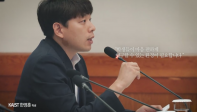
KAIST 전산학부 박사과정 한영훈 학생, 문재인대통령께서 주재한 국가과학기술자문회의 전원..
KAIST 전산학부 박사과정 한영훈(지도교수 강성원) 학생이 지난 7/26(목) 청와대에서 진행된 ‘국가과학기술자문회의 제1회 전원회의’에 KAIST 학생대표로 참석했다. 국가과학기술자문회의 의장인 문재인대통령이 주재한 본 회의에서 1)국가 R&D 혁신방안과 2)대학연구인력 권익강화 및 연구여건 개선방안이라는 주제로 토론을 진행했다. 회의 전, 사전행사로 대학총장, 출연(연)원장 및 학생대표들과 함께 ‘청년과학자 성장을 위한 다짐식’ 행사도 함께 진행되었다. [관련기사] 연합뉴스 http://www.yonhapnews.co.kr/photos/1990000000.html?cid=PYH20180726109200013&input=1196m MBC http://imnews.imbc.com/news/2018/econo/article/4719081_22671.html 청와대 페이스북 https://www.facebook.com/TheBlueHouseKR/videos/2149093512045544/
...Read more -

연구재단 선도연구센터(ERC) 유치
전산학부 오혜연 교수가 연구책임을 맡은 MARS(Massive, Automated, Reliable, Secure) 인공지능 통합연구센터가 한국연구재단 선도연구센터(ERC) 신규과제로 선정되어 2018년부터 2023년까지 총 98.75억의 지원을 받게 된다. MARS 센터는 인공지능의 알고리즘뿐만 아니라 작동 환경과 기반 시스템까지 통합적으로 고려하여, 현실 세계에 곧바로 적용할 수 있는 AI 기술을 개발하는 것을 목표로 하고 있다. MARS 센터에는 전산학부의 오혜연, 신인식, 유신, 양은호, 양홍석, 황성주 교수와 더불어 KAIST 전자공학부, 서울대학교, 성균관대학교가 참여한다. 연구재단 공지 링크: http://nrf.re.kr/biz/notice/view?nts_no=106413&menu_no=44&biz_no=&search_type=&search_keyword=&
...Read more -
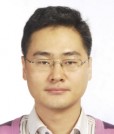
류덕산 박사 전북대학교 조교수 임용
전산학부 졸업생 류덕산 박사(지도 교수 백종문)가 전북대학교 소프트웨어공학과 조교수로 임용되었다. 류덕산 박사는 졸업 후 우리 전산학부에서 2년간 연구 조교수로 근무하였다. 류덕산 박사는 학위 과정 중에는, 소프트웨어 결함 예측 분야를 연구하며 네이버 박사 펠로우십과 전산학부 우수 논문상을 수상하였고, 졸업 후에는 본교에서 프로그래밍 기초, 자료 구조론을 강의했다.
...Read more -

제9회 TOPCIT 정기평가 대상, 특별상 수상
*사진상 왼쪽 류형욱 학생, 오른쪽 권오찬 학생 KAIST 전산학부 석사과정 류형욱 학생(지도교수: 최성희)과 권오찬 학생(지도교수: 최광무)이 지난 5월19일(토) 과학기술정보통신부와 IITP 주관으로 실시한 '제9회 TOPCIT 정기평가'에서 각각 대상(과학기술정보통신부장관상) 과 특별상(해군참모총장상)을 수상했다. 시상식은 오는 2018.7.13.(금), 쉐라톤 서울 팔래스 강남 로얄볼룸(1층)에 진행될 예정이다. TOPCIT은 ICT 산업 종사자 및 SW 개발자가 비즈니스를 이해하고 요구사항에 따른 과제를 해결하여 업무를 성공적으로 수행하는 데 요구되는 기본적인 핵심 지식 · 스킬 · 태도의 종합적인 능력을 진단하고 평가하는 제도이다.
...Read more -

제목만으로 ‘낚시성 기사’ 알 수 있는 기술 나왔다.
우리 전산학부 웹사이언스 졸업생인 박건우 박사(지도교수: 차미영) 와 김태균 학사과정(지도교수: 허재혁)생이 개발한 '낚시성 기사 판독 프로그램'에 대한 기사 입니다. http://news.joins.com/article/22600687
...Read more -
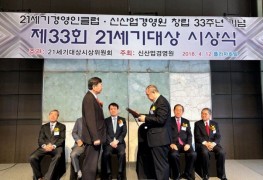
김진형 명예교수 ˝21세기 대상˝ 기술부문 선정
지난 4월 12일 전산학부 명예교수인 김진형 교수가 21세기 대상 기술부문에 선정되었다. 21세기 대상은 신산업경영원이 1986년 21세기 경영인클럽 창립을 기념해 제정한 상으로 국내 산업 발전에 기여한 경영인들을 기리는 ‘재계의 노벨상’으로 평가받는다. 수상을 축하드립니다.
...Read more







